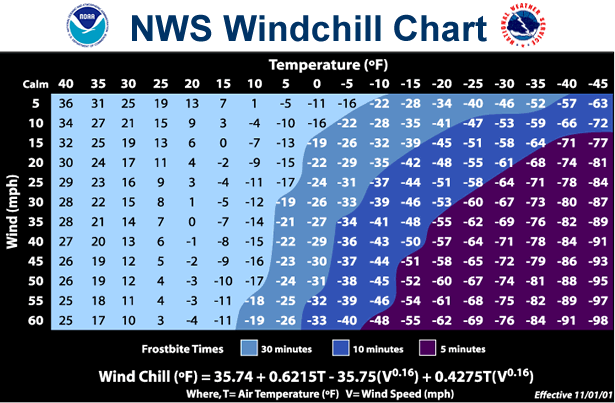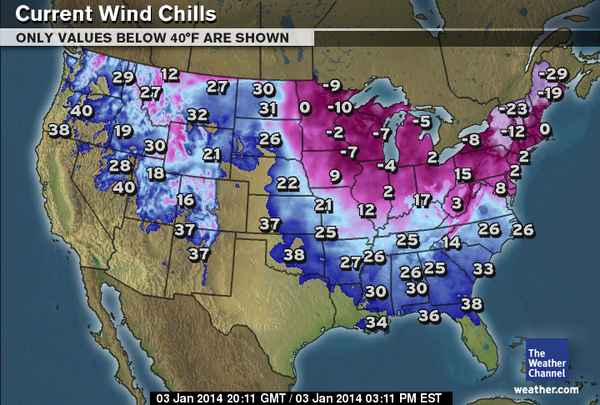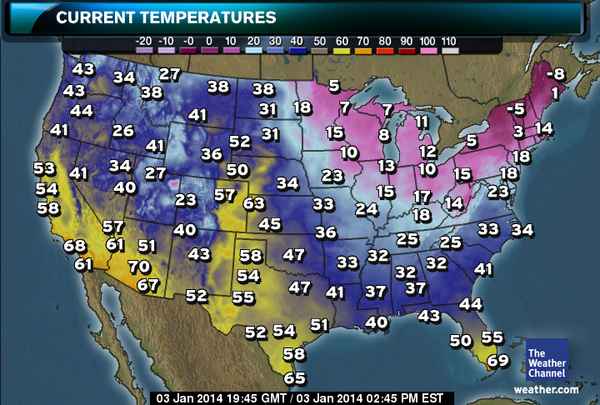If you’re one of the few remaining Minnesotans who actually likes winter, you’re going to have to grin and bear it for the next few days as weatherpeople struggle to describe an awful temperature in more awful terms.
It’ll be sickeningly cold; everyone understands that. So why do weatherpeople work so hard to make it sound even worse by citing the wind chill factor,which is rooted in (some say, “lame”) science, not human understanding, and serves no real purpose for understanding unless you intend to go outside naked next week?
For most people, the windchill factor serves one purpose: To provide people with ammunition to use when an out-of-state friend — in this case the East Coast — complains about the two feet of snow that just fell, or the house that fell into the ocean because of the strong winds. “Oh yeah,” we’ll say, “the windchill here is -70.” It requires us to disrespect the awesome awfulness of 25-below-zero weather in calm winds.
In terms of bravado, which of these charts is more valuable?
What most weatherpeople don’t tell you is the wind chill factor “assumes that your exposed face is roughly five feet off the ground, it’s night, and you’re walking directly into the wind in an open field at a clip of about 3 mph,” according to Mental Floss.
“It’s a meaningless number,” Slate columnist Daniel Engber wrote four years ago, at a time when winter did what it’s supposed to do.
But no amount of tweaking will make wind chill more comprehensible. The language of “equivalent temperatures” creates a fundamental misconception about what wind chill really means. It doesn’t tell you how cold your skin will get; that’s determined by air temperature alone. Wind chill just tells you the rate at which your skin will reach the air temperature. If it were 35 degrees outside with a wind chill of 25, you might think you’re in danger of getting frostbite. But your skin can freeze only if the air temperature is below freezing. At a real temperature of 35 degrees, you’ll never get frostbite no matter how long you stand outside. And despite a popular misconception, a below-32 wind chill can’t freeze our pipes or car radiators by itself, either.
The recent fiddling with wind chill has only made the numbers less useful. The old system might have overstated the numbers when it said that 5 degrees could feel like minus 40. But after three decades of practice, we all got pretty good at translating from the outrageous numbers in the weather reports to our own experience. When the weather service recalibrated the system in 2001, we had to start all over and rebuild our frame of reference from scratch.
Rather than trying to patch up wind chill’s inconsistencies, we should just dump it altogether. The best algorithm we’ll ever have for determining how cold it feels comes from our own experience. A look out the window gives us most of the variables we need to compute our own, personal weather index. The sight of a few leafy trees will tell us how windy it is on our corner and whether the breeze is swirling or gusting. We’ll see if the sun is shining or if the sky is overcast. We’ll also know how we’re dressed, how tall we are, how much we weigh, and how quickly we walk down the street. We can even stick our hand outside for a moment, to get a sample of the ambient air temperature.
If you’ve been out in -20 weather before, you know what it feels like. The brain, Engber notes, has been tallying up all these variables for you, for years. It feels like -20. Period. Maybe the wind was blowing, maybe it wasn’t. But your body and brain don’t differentiate. It was cold. Your nasal mucus froze. You made the mistake of blinking and your eyes froze shut. The dog peed in the living room instead of going outside. That’s useful data.
The wind chill is irrelevant to almost everything else. It doesn’t affect your car in any way. It doesn’t affect your feet or any other body part — that is to say: almost all of your body — if you have the kind of clothing that people put on when it’s -20 anyway.
If you leave it outside Sunday night, your car probably isn’t going to start on Monday morning. Why? Because it’s -20, the temperature that we disrespect so much we don’t trust it to adequately convey our misery, except last week when it was zero with a wind speed of 15 mph and we exclaimed, “wow, that feels like minus 20” to our friends, who were — you’ll recall — pretty impressed with you for still living here.
Still, the National Weather Service has posted a wind chill warning for our area, predicting -35 to -60 wind chills, and warning exposed flesh will freeze in 10 minutes at that level, or about 4 minutes earlier than -20 with no wind. The Weather Service offers this guideline for dealing with the situation: Consider staying indoors.
Temperature, we can safely say, is all relative anyway, as proven by this famous Canada-U.S. temperature conversion chart:
50 Fahrenheit (10 C)
Californians shiver uncontrollably.
Canadians plant gardens.35 Fahrenheit (1.6 C)
Italian Cars won’t start
Canadians drive with the windows down32 Fahrenheit (0 C)
American water freezes
Canadian water gets thicker.0 Fahrenheit (-17..9 C)
New York City landlords finally turn on the heat.
Canadians have the last cookout of the season.-60 Fahrenheit (-51 C)
Santa Claus abandons the North Pole.
Canadian Girl Guides sell cookies door-to-door.-109.9 Fahrenheit (-78.5 C)
Carbon dioxide freezes makes dry ice.
Canadians pull down their earflaps.-173 Fahrenheit (-114 C)
Ethyl alcohol freezes.
Canadians get frustrated when they can’t thaw the keg-459.67 Fahrenheit (-273.15 C)
Absolute zero; all atomic motion stops.
Canadians start saying “cold, eh?”-500 Fahrenheit (-295 C)
Hell freezes over.
The Toronto Maple Leafs win the Stanley Cup.
So if the wind chill hits -35 on Monday morning, run outside naked for nine minutes and 59 seconds, and call your East Coast pals. Tell them the actual temperature and what you just did and see if they can top it with their little snowstorm.
If it doesn’t impress them, just tell them it’s colder here than the surface of Mars.



